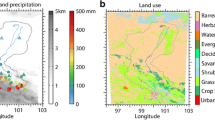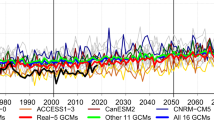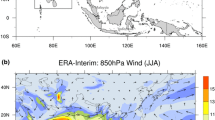Abstract
Winter precipitation (PR) characteristics in western United States (WUS) related to atmospheric river (AR) landfalls are examined using the observation-based PRISM data. The observed AR-related precipitation characteristics are in turn used to evaluate model precipitation data from the NASA MERRA2 reanalysis and from seven dynamical downscaling simulations driven by the MERRA2. Multiple metrics including mean bias, Taylor diagram, and two skill scores are used to measure model performance for three climatological sub-regions in WUS, Pacific Northwest (PNW), Pacific Southwest (PSW) and Great Basin (GB). All model data well represent the winter-mean PR with spatial pattern correlations of 0.8 or higher with PRISM for the three sub-regions. Higher spatial resolutions and/or the use of spectral nudging generally yield higher skill scores in simulating the geographical distribution of PR for the entire winter. The PRISM data shows that the AR-related fraction of winter PR and associated daily PR PDFs in each region vary strongly for landfall locations; AR landfalls in the northern WUS coast (NC) affect mostly PNW while those in the southern WUS coast (SC) affect both PSW and GB. NC (SC) landfalls increase the frequency of heavy PR in PNW (PSW and GB) but reduce it in PSW (PNW). All model data reasonably represent these observed variations in the AR-related winter PR fractions and the daily PR PDFs according to AR landfall locations. However, unlike for the entire winter period, no systematic effects of resolution and/or spectral nudging are identified in these AR-related PR characteristics. Dynamical downscaling in this study generally yield positive added values to the MERRA2 PR in the AR-related PR fraction for most sub-regions and landfall locations, most noticeably for PSW by NU-WRF. The downscaling also generate positive added value in p95 for PNW, but negative values for PSW and GB due to overestimation of heavy precipitation events.













Similar content being viewed by others
References
Bacmeister JT, Suarez MJ, Robertson FR (2006) Rain re-evaporation, boundary-layer/convection interactions and Pacific rainfall patterns in an AGCM. J Atmos Sci 8:3383–3403
Boville B (1991) Sensitivity of simulated climate to model resolution. J Climate 4:469–485
Bukovsky MS, Gochis DJ, Mearns LO (2013) Towards assessing NARCCAP regional climate model credibility for the North American monsoon: current climate simulations. J Clim. doi:10.1175/JCLI-D-12-00538.s1
Carvalho A, Ferreira J, Arreola J, Carvalho AC, Miranda A, Alonso S, Berrego C (2002) Sensitivity tests of MM5 modelling system over a coastal region in Portugal. In: Breddia, Duque M (eds) Air Pollution X. WIT Press, Ashurst Lodge, pp 503–512. ISBN 1-85312-916-X
Carvalho D, Rocha A, Gomez-Gesteira M, Santos C (2012) A sensitivity study of the WRF model in wind simulation for an area of high wind energy. Environ Model Softw 33:23–34
Castro C, Pielke R Sr, Leoncini G (2005) Dynamical downscaling: assessment of value retained and added using the Regional Atmospheric Modeling System (RAMS). J Geophys Res 110:D05108. doi:10.1029/2004/2004JD004721
Cha D-H, Jin C-S, Moon J-H, Lee D-K (2016) Improvement of regional climate model simulation of East Asian summer monsoon by coupled air-sea interaction and large-scale nudging. Int J Climatol 36:334–345
Chou M-D, Suarez MJ (1994) An efficient thermal infrared radiation parameterization for use in general circulation models. NASA Tech Memo 104606:85
Chou M-D, Suarez MJ (1999) A solar radiation parameterization for atmospheric studies. NASA Tech. Rep. NASA/TM-1999-10460, 15
Daly C, Neilson RP, Phillips DL (1994) A statistical-topographic model for mapping climatological precipitation over mountainous terrain. J Appl Meteorol 33:140–158
Daly C, Halbleib M, Smith JJ, Gibson WP, Doggett MK, Taylor GH, Curtis J, Pasteris PP (2008) Physiographically sensitive mapping of climatological temperature and precipitation across the conterminous United States. Int J Climatol. doi:10.1002/joc0.1688
Dettinger M (2011) Climate change, atmospheric rivers, and floods in California—a multi-model analysis of storm frequency and magnitude change. J Am Water Resour Assoc 47:514–523
Dettinger M, Ralph FM, Das T, Neiman PJ, Cayan D (2011) Atmospheric rivers, floods, and the water resources of California. Water 3:445–478. doi:10.3390/w3020445
Di Luca A, de Elia R, Laprise R (2011) Potential for added value in precipitation simulated by high-resolution nested regional climate models and observations. Clim Dyn 1:1–19
Ek MB, Mitchell KE, Lin Y, Rogers E, Grunmann P, Koren V, Gayno G, Tarpley JD (2003) Implementation of Noah land surface model advances in the National Centers for Environmental Prediction operational mesoscale Eta Model. J Geophys Res 108:8851
Feser F, Rockel B, von Storch H, Winterfeldt J, Zahn M (2011) Regional climate models and add value to global model data: a review and selected examples. Bull Am Meteorol Soc 92:1181–1192
Garcia-Diez M, Fernández J, San-Martin D, Herrera S, Gutiérrez J (2015) Assessing and improving the local added value of WRF for wind downscaling. J Appl Meteorol Clim 54:1556–1568
Giorgi F, Gutowski W Jr (2015) Regional dynamical downscaling and CORDEX initiative. Annu Rev Environ Resour 40:467–490. doi:10.1146/annurev-environ-102014-021217
Grell G, Dévényi D (2002) A generalized approach to parameterizing convection combining ensemble and data assimilation techniques. Geophys Res Lett. doi:10.1029/2002GL015311
Guan B, Waliser DE (2015) Detection of atmospheric rivers: Evaluation and application of an algorithm for global studies. J Geophys Res Atmos 120:1251412535. doi:10.1002/2015JD024257
Guan B, Molotch N, Waliser D, Fetzer E, Neiman P (2010) Extreme snowfall events linked to atmospheric rivers and surface air temperature via satellite measurements. Geophys Res Lett. doi:10.1029/2010GL044696
Guan B, Waliser DE, Ralph FM, Fetzer EJ, Neiman PJ (2016) Hydrometeorological characteristics of rain-on-snow events associated with atmospheric rivers. Geophys Res Lett. doi:10.1002/2016GL067978
Iguchi T, Tao W, Wu D, Peters-Lidard C, Santanello JA Jr, Kemp E, Tian Y, Case J, Wang W, Ferraro R, Waliser D, Kim J, Lee H, Guan B, Tian B, Loikith P (2016) Sensitivity of CONUS summer rainfall to the selection of cumulus parameterization scheme in NU-WRF climate simulations. J Hydrometeorol (under revision)
Janjić ZI (2002) Nonsingular Implementation of the Mellor-Yamada Level 2.5 Scheme in the NCEP Meso model. NCEP Office Note, No. 437
Kabela E, Carbone G (2015) NARCCAP model skill and bias for the southwest United States. Am J Clim Change 4:94–114
Kalnay E et al (1996) The NCEP/NCAR 40-year reanalysis project. Bull Am Meteorol Soc 77:437–471
Kang H, Cha D, Lee D (2005) Evaluation of the MM5/LSM coupled model for East Asian summer monsoon simulations. J Geophys Res 110:D10105. doi:10.1029/2004jd005266
Kim J (1997) Precipitation and snow budget over the southwestern United States during the 1994–1995 winter season in a mesoscale model simulation. Water Resour Res 33:2831–2839
Kim J, Kang H (2007) The impacts of the Sierra Nevada on low-level wind and water vapor transport. J Hydrometeorol 8:790–804
Kim J, Lee J-E (2003) A multi-year regional climate hindcast for the western United States using the Mesoscale Atmospheric Simulation model. J Hydrometeorol 4:878–890
Kim J, Park S (2016) Uncertainties in calculating precipitation climatology in East Asia. Hydrol Earth Syst Sci 20:651–658
Kim J, Miller N, Guetter A, Georgakakos K (1998) River flow response to precipitation and snow budget in California during the 1994/95 winter. J Clim 11:2376–2386
Kim J, Miller N, Farrara J, Hong S (2000) A seasonal precipitation and streamflow hindcast and prediction study in the western United States during the 1997/98 winter season using a dynamical downscaling system. J Hydrometeorol 1:311–329
Kim J, Waliser DE, Neiman PJ, Guan B, Ryoo J-M, Wick GA (2013a) Effects of atmospheric river landfalls on the cold season precipitation in California. Clim Dyn 40:465–474
Kim J, Waliser DE, Mattmann CA, Mearns LO, Goodale CE, Hart AF, Crichton DJ, McGinnis S, Lee H, Loikith PC, Boustani M (2013b) Evaluation of the surface climatology over the conterminous United States in the North American Regional Climate Change Assessment Program hindcast experiment using a Regional Climate Model Evaluation System. J Clim 26:5698–5715
Kim J, Sanjay J, Mattmann C, Boustani M, M.V.S. Ramarao, Krishnan R, Waliser D (2015) Uncertainties in estimating spatial and interannual variations in precipitation climatology in the India-Tibet region from multiple gridded precipitation datasets. Int J Climatol 35:4557–4573
Koster RD, Suarez MJ, Ducharne A, Stieglitz M, Kumar P (2000) A catchment-based approach to modeling land surface processes in a GCM, Part 1, Model structure. J Geophys Res 105:24809–24822
Leung R, Ghan S (1998) Parameterizing subgrid orographic precipitation and surface cover in climate models. Mon Weather Rev 126:3271–3291
Leung R, Qian Y (2009) Atmospheric rivers induced heavy precipitation and flooding in the western U.S. simulated by the WRF regional climate model. Geophys Res Lett 36:L03820. doi:10.1029/2008GL036445
Lock AP, Brown AR, Bush MR, Martin GM, R.N.B. Smith (2000) A new boundary layer mixing scheme. Part I: scheme description and single-column model tests. Mon Weather Rev 138:3187–3199
Mearns LO, Sain S, Leung LR, Bukovsky MS, McGinnis S, Biner S, Caya D, Arritt RW, Gutowski W, Takle E, Snyder M, Jones RG, A.M.B. Nunes, Tucker S, Herzmann D, McDaniel L, Sloan L (2013) Climate change projections of the North American Regional Climate Change Assessment Program (NARCCAP). Clim Change 120:965–975
Miller N, Kim J (1996) Numerical prediction of precipitation and river flow over the Russian River watershed during the January 1995 California storms. Bull Am Meteorol Soc 77:101–105
Mohan M, Bhati S (2011) Analysis of WRF model performance over subtropical region of Delhi, India. Adv Meteorol 2011:Article ID 621235. doi:10.1155/2011/621235
Molod A, Takacs L, Suarez M, Bacmeister J, Song I-S, Eichmann A (2012) The GEOS-5 atmospheric general circulation model: mean climate and development from MERRA to Fortuna. NASA/TM-2012-104606, 28
Moorthi S, Suarez MJ (1992) Relaxed Arakawa Schubert: a parameterization of moist convection for general circulation models. Mon Weather Rev 120:978–1002
Neiman PJ, Ralph FM, White AB, Kingsmill DE, Persson P (2002) The statistical relationship between upslope flow and rainfall in California’s coastal mountains: observations during CALJET. Mon Weather Rev 130:1468–1492
Neiman PJ, Ralph FM, Wick GA, Kuo Y, Lee T, Taylor GH, Dettinger MD (2008) Diagnosis of an intense atmospheric river impacting the Pacific Northwest: storm summary and offshore vertical structure observed with COSMIC satellite retrievals. Mon Weather Rev 136:4398–4420
Perkins S, Pitman A, Holbrook N, McAneney J (2008) Evaluation of the AR4 climate models’ simulated daily maximum temperature, minimum temperature, and precipitation over Australia using probably density functions. J Clim 20:4356–4376
Peters-Lidard CD, Kemp EM, Matsui T, Santanello JA, Kumar SV, Kumar, Jacob JP, Clune T, Tao W-K, Chin M, Hou A, Case JL, Kim D, Kim K-M, Lau W, Liu Y, Shi J-J, Starr D, Tan Q, Tao Z, Zaitchik BF, Zavodsky B, Zhang SQ, Zupanski M (2015) Integrated modeling of aerosol, cloud, precipitation and land processes at satellite-resolved scales. Environ Model Softw 67:149–159
Rachel P, Shindell D, Faluvegi G (2012) The added value to global model projections of climate change by dynamical downscaling: a case study over the continental U.S. using the GISS-ModelE2 and WRF models. J Geophys Res 117:D20118. doi:10.1029/2012jd018091
Reichle RH, Liu Q (2014) Observation corrected precipitation estimates in GEOS5. In: Koster RD (ed) Technical report series on global modeling and data assimilation, vol 35, pp 1–18
Schwaller MR, Morris KR (2011) A ground validation network for the global precipitation measurement mission. J Atmos Ocean Technol 28:301–319
Soong S, Kim J (1996) Simulation of a heavy wintertime precipitation event in California. Clim Change 32:55–77
Stoklosa J, Daly C, Foster S, Ashcroft M, Warton D (2015) A climate of uncertainty: accounting for errors and spatial variability in climate variables for species distribution models. Methods Ecol Evol 6:412–423. doi:10.1111/2041-210X12217
Tao WK, Simpson J, Baker D, Braun S, Chou MD, Ferrier B, Johnson D, Khain A, Lang S, Lynn B (2003) Microphysics, radiation and surface processes in the Goddard Cumulus Ensemble (GCE) model. Meteorol Atmos Phys 82(1):97–137
Tao Z, Yu H, Chin M (2016) Impact of transpacific aerosol on air quality over the United States: a perspective from aerosol–cloud–radiation interactions. Atmos Environ 125:48–60
Taylor K (2001) Summarizing multiple aspects of model performance in a single diagram. J Geophys Res 106:7183–7192
Waliser DE, Kim J, Xue Y, Chao Y, Eldering A, Fovell R, Hall A, Li Q, Liou KN, McWilliams J, Kapnick S, Vasic R, De Sale F, Yu Y (2011) Simulating cold season snowpack: Impacts of snow albedo and multi-layer snow physics. Clim Change 109:S95–S117
Whan K, Zwiers F (2016) Evaluation of extreme rainfall and temperature over North America in CanRCM4 and CRCM5. Clim Dyn 46:3821–3843
Zaitchik BF, Santanello JA, Kumar SV, Peters-Lidard CD (2013) Representation of soil moisture feedbacks during drought in NASA Unified WRF (NU-WRF). J Hydrometeorol 14:360–367
Zhu Y, Newell R (1994) Atmospheric rivers and bombs. Geophys Res Lett 21:1999–2002
Acknowledgements
This study was supported by the NASA Downscaling Project, the NASA National Climate Assessment (NCA) project, NASA NEWS program, and the NASA AIST project. High performance computational resources were provided by NASA High Performance Computing (HPC) facilities including the NASA Center for Climate Simulation (NCCS) at Goddard Space Flight Center (GSFC) and the NASA Advanced Supercomputing (NAS) Division at Ames Research Center. The MERRA2 data was provided by the NASA Global Modeling and Assimilation Office. Special thanks to Melissa Bukovsky for providing 1-km resolution mask files for the three sub-regions. The contribution from JPL personnel was performed on behalf of the Jet Propulsion Laboratory, California Institute of Technology, under a contract with the National Aeronautics and Space Administration.
Author information
Authors and Affiliations
Corresponding author
Rights and permissions
About this article
Cite this article
Kim, J., Guan, B., Waliser, D.E. et al. Winter precipitation characteristics in western US related to atmospheric river landfalls: observations and model evaluations. Clim Dyn 50, 231–248 (2018). https://doi.org/10.1007/s00382-017-3601-5
Received:
Accepted:
Published:
Issue Date:
DOI: https://doi.org/10.1007/s00382-017-3601-5




